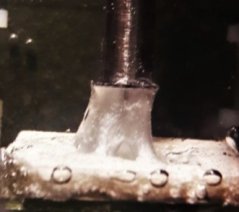Project
Graft them all: synthesis of oppositely charged graft polyelectrolytes and development of underwater adhesives using complex coacervation (MSc Marco Dompe)

Inspired by these biological organisms, we are modifying the chemistry of synthetic polyelectrolytes so that additional strengthening mechanisms can be introduced into the material, making it suitable for biomedical applications. In this project, we attach thermoresponsive side chains on a polyelectrolyte backbone in order to produce graft copolymers. By properly tuning the environmental parameters (such as pH, ionic strength, mixing ratio..), complex coacervation is achieved by mixing aqueous solutions of oppositely charged polyelectrolytes: associative phase separation occurs and a polymer-poor (dilute) phase and a polymer-rich (coacervate) phase are obtained. The coacervate phase (in which we are interested in) is a viscous liquid at room temperature but it becomes gel-like when the temperature is increased above a certain threshold, which is few degrees lower than the human body temperature (fig.1). This behaviour makes the modified coacervate an ideal candidate for tissue repair or wound closure: the adhesive is a liquid at room temperature, facilitating the delivery and the wettability inside the human body, but it turns into a load-bearing solid immediately after the application because of the temperature trigger.
In this project, we accurately follow every single step of the material development, starting from the synthesis of the polylectrolyte components to the characterization of the final adhesive using techniques such as NMR, rheology, underwater adhesion (fig.2) and scattering measurements.
